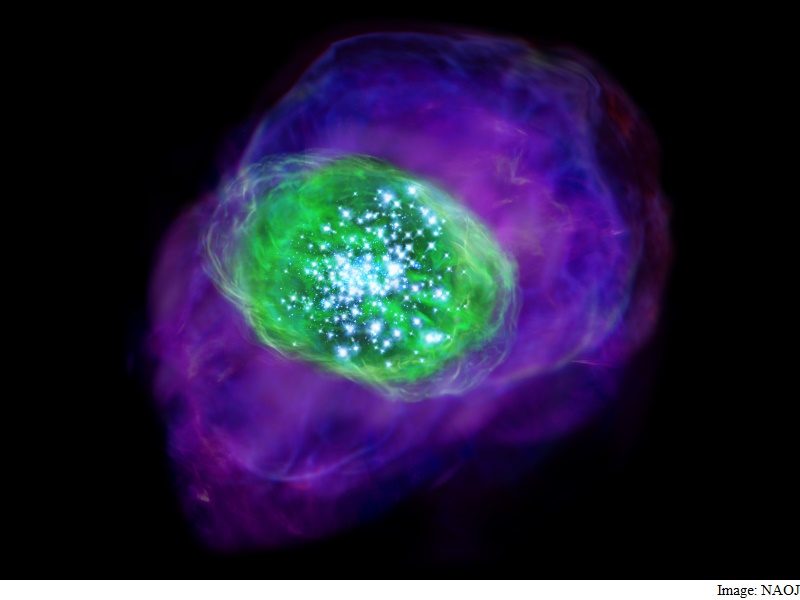- Home
- Science
- Science News
- Scientists Discover the Most Distant Galaxy With Oxygen Yet
Scientists Discover the Most Distant Galaxy With Oxygen Yet

Using the Atacama Large Millimetre/submillimetre Array (ALMA) in Chile, astronomers detected glowing oxygen in a distant galaxy.
The galaxy SXDF-NB1006-2 lies at a redshift of 7.2, meaning that we see it only 700 million years after the Big Bang, researchers said.
The team was hoping to find out about the heavy chemical elements present in the galaxy, as they can tell us about the level of star formation, and hence provide clues about the period in the early universe known as cosmic reionisation.
"Seeking heavy elements in the early universe is an essential approach to explore the star formation activity in that period," said Akio Inoue from the Osaka Sangyo University in Japan.
"Studying heavy elements also gives us a hint to understand how the galaxies were formed and what caused the cosmic reionisation," said Inoue.
In the time before objects formed in the universe, it was filled with electrically neutral gas.
However, when the first objects began to shine, a few hundred million years after the Big Bang, they emitted powerful radiation that started to break up those neutral atoms - to ionise the gas.
During this phase - known as cosmic reionisation - the whole universe changed dramatically.
Researchers carried out high-sensitivity observations with ALMA and found light from ionised oxygen in SXDF-NB1006-2, making this the most distant unambiguous detection of oxygen ever obtained.
It is firm evidence for the presence of oxygen in the early Universe, only 700 million years after the Big Bang.
Oxygen in SXDF-NB1006-2 was found to be ten times less abundant than it is in the Sun.
"The small abundance is expected because the universe was still young and had a short history of star formation at that time," said Naoki Yoshida at the University of Tokyo.
The team was unable to detect any emission from carbon in the galaxy, suggesting that this young galaxy contains very little un-ionised hydrogen gas, and also found that it contains only a small amount of dust, which is made up of heavy elements.
The detection of ionised oxygen indicates that many very brilliant stars, several dozen times more massive than the Sun, have formed in the galaxy and are emitting the intense ultraviolet light needed to ionise the oxygen atoms.
The findings were published in the journal Science.
Get your daily dose of tech news, reviews, and insights, in under 80 characters on Gadgets 360 Turbo. Connect with fellow tech lovers on our Forum. Follow us on X, Facebook, WhatsApp, Threads and Google News for instant updates. Catch all the action on our YouTube channel.
Related Stories
- Samsung Galaxy Unpacked 2025
- ChatGPT
- Redmi Note 14 Pro+
- iPhone 16
- Apple Vision Pro
- Oneplus 12
- OnePlus Nord CE 3 Lite 5G
- iPhone 13
- Xiaomi 14 Pro
- Oppo Find N3
- Tecno Spark Go (2023)
- Realme V30
- Best Phones Under 25000
- Samsung Galaxy S24 Series
- Cryptocurrency
- iQoo 12
- Samsung Galaxy S24 Ultra
- Giottus
- Samsung Galaxy Z Flip 5
- Apple 'Scary Fast'
- Housefull 5
- GoPro Hero 12 Black Review
- Invincible Season 2
- JioGlass
- HD Ready TV
- Laptop Under 50000
- Smartwatch Under 10000
- Latest Mobile Phones
- Compare Phones
- Redmi Note 15 5G
- Redmi Note 15 Pro 5G
- Redmi Note 15 Pro+ 5G
- Lava Play Max
- Poco C85 5G
- Honor Magic 8 Lite
- Jolla Phone
- Realme P4x 5G
- Asus ProArt P16
- MacBook Pro 14-inch (M5, 2025)
- OnePlus Pad Go 2
- Poco Pad M1
- Just Corseca Skywatch Pro
- Honor Watch X5
- Acerpure Nitro Z Series 100-inch QLED TV
- Samsung 43 Inch LED Ultra HD (4K) Smart TV (UA43UE81AFULXL)
- Asus ROG Ally
- Nintendo Switch Lite
- Haier 1.6 Ton 5 Star Inverter Split AC (HSU19G-MZAID5BN-INV)
- Haier 1.6 Ton 5 Star Inverter Split AC (HSU19G-MZAIM5BN-INV)

















